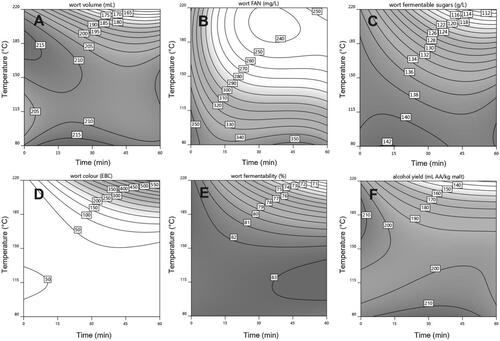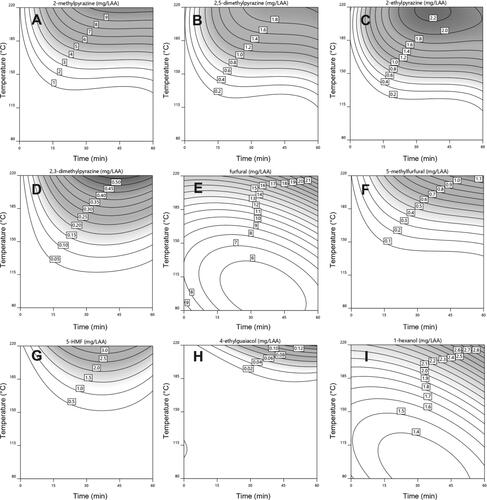Figures & data
Table 1. Summary of observed characteristics of roasted pot still malt (80–220 °C, 0–60 min) and distilled spirit (using 30% roasted malt inclusion).
Figure 1. Impact of roasting time (min) and temperature (°C) on development of typical malt quality characteristics in pot still malt. (A) hot water extract on dry basis (L°/kg); (B) cold water extract (% w/w); (C) wort fermentability (%); (D) wort fermentable sugars (g/L); (E) wort free amino nitrogen (mg/L); (F) wort color (EBC units); (G) wort pH; (H) 1000 corn weight (g); and (I) wort volume (mL). Roasted malt inclusion rate was 100% in analyses represented in graphs B and H, and 50% in graphs A, C-G and I. Darker tones indicate an increase in the given parameter.

Table 2. Bivariate correlation analysis of roasted malt properties displayed as Spearman’s rank correlation coefficient.a
Figure 2. Characteristics of high gravity wort (made with 30% roasted malt) as a function of roasting time (min) and temperature (°C): (A) wort volume (mL), (B) wort free amino nitrogen (mg/L), (C) wort fermentable sugars (g/L), (D) wort color (EBC units), (E) wort fermentability (%), and (F) alcohol yield (mL AA/kg malt). Darker tones indicate an increase in the given parameter.

Figure 3. Characteristics of wort prepared with 0–50% roasted malt (140, 180, and 220 °C temperature roasts for 30 min): (A) collected wort volume (mL); (B) fermentability (%); and (C) alcohol yield (mL AA/kg malt). Error bars indicate the standard deviation of triplicate independent samples.

Figure 4. Concentrations of aroma volatiles in spirit (mg/LAA; made with 30% roasted malt, high gravity wort), as a function of roasting time (min) and temperature (°C): (A) 2-methylpyrazine; (B) 2,5-dimethylpyrazine; (C) 2-ethylpyrazine; (D) 2,3-dimethylpyrazine; (E) furfural; (F) 5-methylfurfural; (G) 5-(hydroxymethyl)furfural; (H) 4-ethylguaiacol; and (I) 1-hexanol. Darker tones indicate an increase in the given parameter.

Figure 5. Concentrations of aroma volatiles in spirit (mg/LAA), made including 0–50% of roasted malt: (A) 2-methylpyrazine; (B) 2,5-dimethylpyrazine; (C) 2-ethylpyrazine; (D) 2,3-dimethylpyrazine; (E) furfural; (F) 5-methylfurfural; (G) benzaldehyde; (H) 4-ethylguaiacol; and (I) 1-hexanol. Error bars indicate the standard deviation of three independent samples.

